Wiggle Bug For Silver Salmon
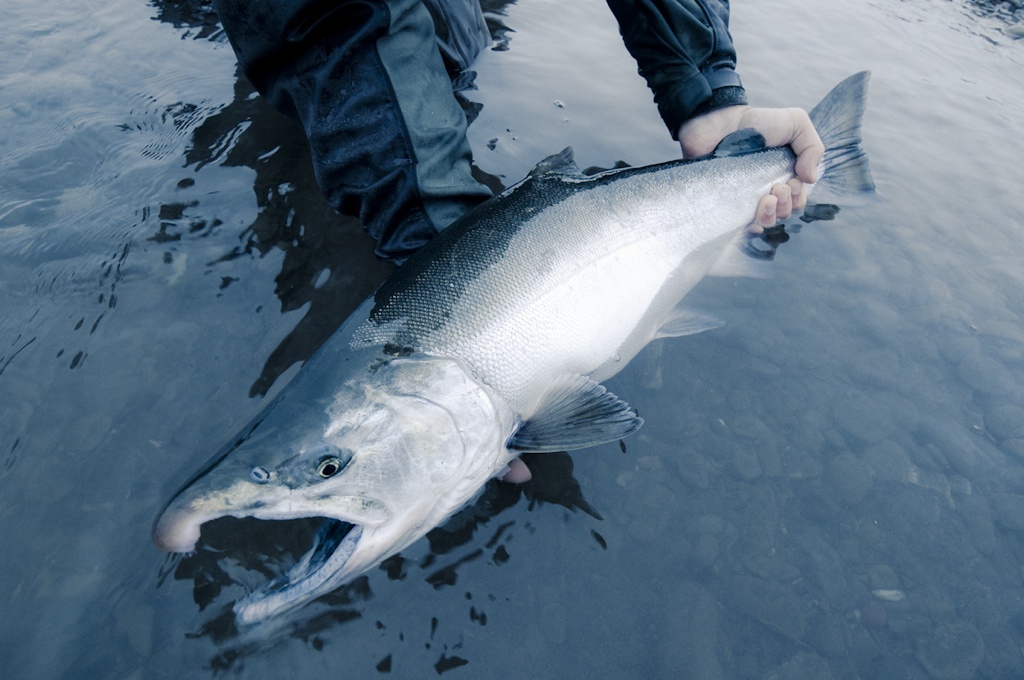
Who doesn’t love watching a big silver salmon rushing towards a fly and crushing it?
I’ll tell you who, an Alaskan guide who’s already unhooked three dozen of them for the day.
I used to really enjoy guiding first time silver clients in Alaska. You wouldn’t believe the praises you’d get as a guide after they landed twenty or so. It was sometimes hard keeping a straight face, smiling and saying, thanks man! But in my head I’m thinking, it’s not brain surgery, this is about as easy as Alaska fishing gets. Seriously though, I really did enjoy the high fives and genuine remarks I received during those trips. Silver fishing did get a little monotonous at times but it was always an easy day of guiding, something guides cherish after months in the bush. Silver salmon are super territorial and aggressive during the spawn, making them eager to chase and attack flies that enter their field of vision. It’s not technical fly fishing by any means but a lot of fun for fly anglers wanting action all day long. The only thing I truly hated about silver salmon fishing was the beating my hands took from trying to handle them death rolling in the net. If you ever get a chance take a good hard look at an alaskan guides hands. It’s not a pretty sight. I never thought my hands would look the same after that season in Alaska. Thank God for utter cream.
Read More »Organizing Your Bonefish Fly Box Makes For A Better Day Of Fishing
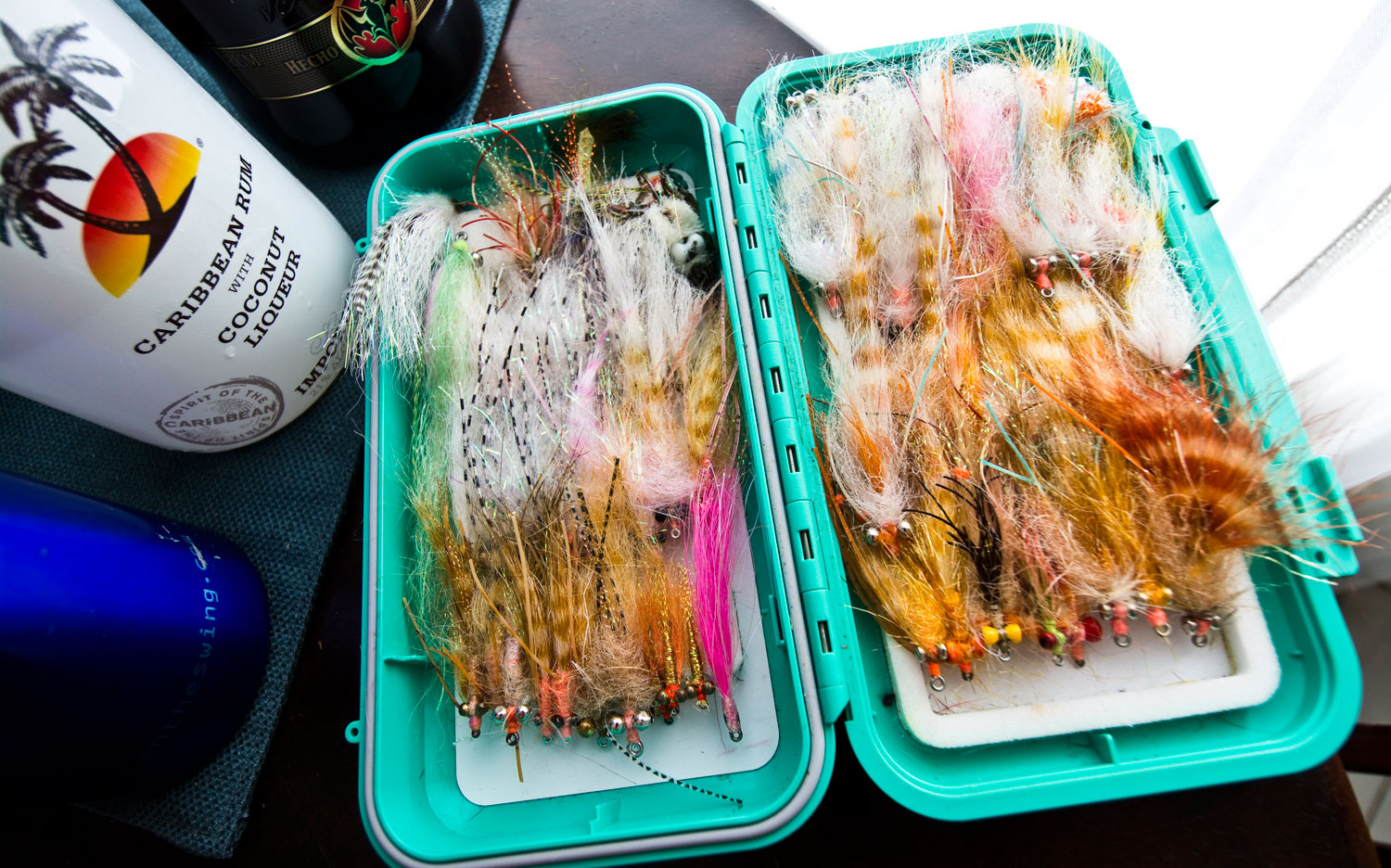
OPTION PARALYSIS EATS UP VALUABLE FISHING TIME.
I’ve found myself, more than once, staring into my fly box as if I’d wandered to the refrigerator in the middle of the night, with no idea why I was there. That’s fine, unless you’re surrounded by feeding bonefish and your guide is wailing in tongues. Even if your not under pressure to make a quick fly choice, having your flies organized in a logical fashion will help you choose the right fly for the conditions and that means catching more fish. Here are some tips on how I organize my bonefish box and how I use that organization to make better fly choices.
Keep It Simple
Bonefishing is not generally a match-the-hatch situation. Bonefish are highly opportunistic and presentation usually trumps pattern. I know guys that carry a thousand flies on the flats boat. They might fish three of them in a day. I keep it to one box. I probably cram a hundred flies into it but that one box has everything I need.
Making Smart Choices
When paring down your fly selection it’s important to understand
Don’t Hate the River
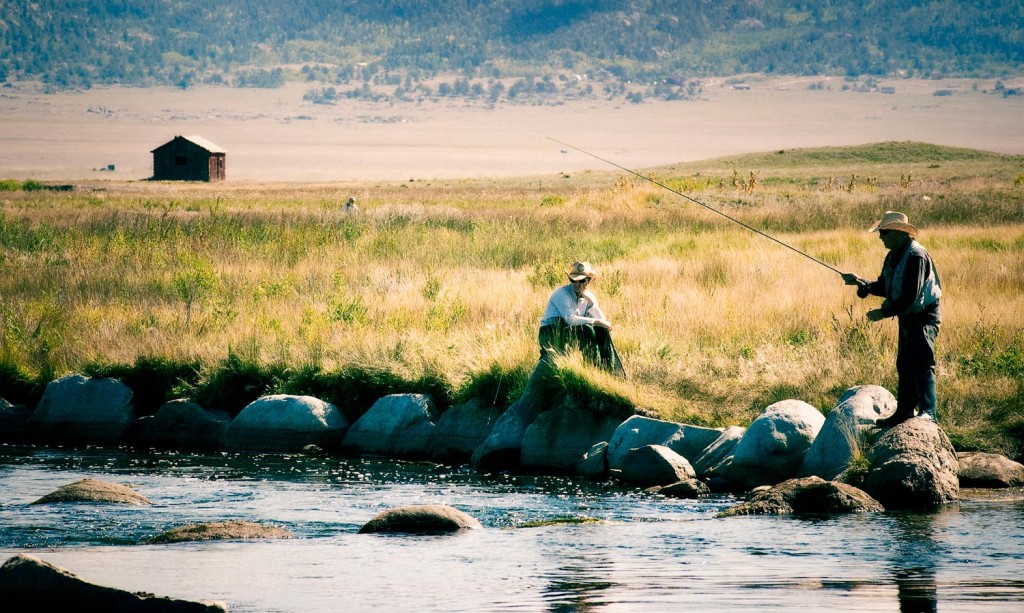
I was talking with a friend the other day about doing some fishing in Colorado, his home state.
This is a good topic to bring up if you are trying to lure me into an extended conversation. Colorado is near to my heart. He was throwing out places we might fish and said “I know you love the Dream Stream, but I hate that place”. This really took me off guard. How could anyone hate that place? If you’ve never fished it, trust me, the name says it all. A gorgeous high elevation tailwater, this section of the South Platte snakes thru a quant little valley between two reservoirs, bending back on itself time and time again, each glass clear bend stacked with big, beautiful, educated trout. What’s so terrible about that?
I do love that place and I’ve had some great days there the best being the first. Kent and I showed up with one of the S. Platte’s famous trico hatches in full swing. Glass calm runs turning into boiling caldrons of rising fish. Kent’s triple trico was born that day. The hatch was epic but we caught great fish all day using everything from dries to streamers. How can you hate a place like that? The answer is pretty simple, pressure.
You can’t put a stream like that a couple of hours drive from a major metropolitan area and not expect the word to get out. It’s true that the Dream Stream sees a ton of traffic but I’ve always had good experiences there and on a lot of other highly pressured rivers and I think it’s more than luck. Some of it is strategy and some of it is outlook.
Read More »Redneck Driftboating
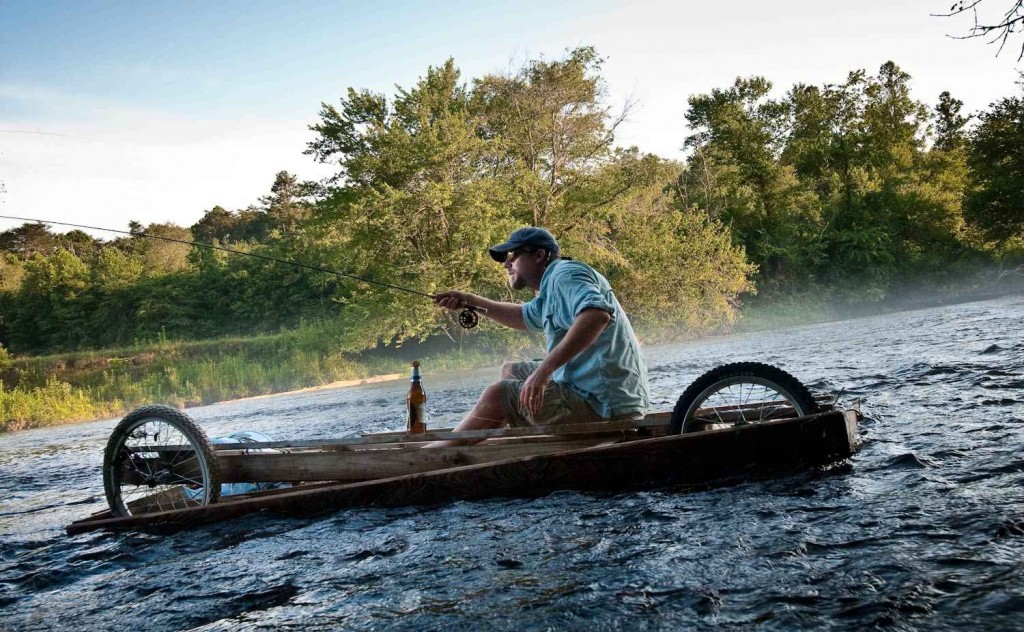
Yes, someone actually took the time to build this pathetic hybrid driftboat/soap box derby car.
Louis and I found it snagged on a shallow riffle and abandoned on my home tailwater the other day. It was comprised of two ten gallon sealed water canisters at the bow and stern. The hull was built with a two-by-four frame and plywood deck, and bicycle tires were fastened at the corners. I’m guessing the redneck engineering idea was that the design would be much easier to roll over shallow shoals while drifting the extreme low water flows. Here’s the scary part, whoever captained this boat/car, actually made it two miles down stream before it fell apart. I only wish I would have been there to witness it’s maiden voyage, and then force them to burn it into a pile of ashes along the riverbank.
I really can’t blame whoever built this thing though. My driftboat doesn’t do much better with the pathetic 120-150cfs of water the TVA blesses me with annually. Right now, 50% of the United States is in severe drought for 2012 and many trout seasons on watersheds across the country will be cut short significantly this year. I feel sorry for all the fly fishing guides and fly shops that will suffer this year because of the drought. For all you out there that fall into this category, here’s something positive to be grateful for. Just be happy you’re not me.
Read More »Cut A Dovetail Every Day

Woodworking has taught me a few things about fly fishing.
Before Gink and Gasoline I was, for a time, very involved in the world of woodworking. I was fortunate to photograph and spend time working with some of the most talented folks in the field, many of them are still great friends. I still build my own furniture, in fact I just finished making a new set of cabinets for my kitchen, but it’s a hobby, not a job.
It was the early 2000s when I met Frank Klausz, a Hungarian-born furniture maker working in New Jersey. Frank specialized in high-end custom furnishings and reproductions and wrote books and magazine articles as well as instructional DVDs. An old world craftsman with a sterling work ethic and a great sense of humor, his name will be familiar to anyone who has studied the craft.
Frank is specifically known for his hand cut dovetail joinery. For many, hand cutting dovetail joints is the skill which separates the hobbyist from the artist. It is the kind of skill that’s bedeviling to master, while the master makes it look almost automatic. I had hand cut a few projects before I met Frank, but he was the one who really turned the lights on for me.
Cutting a perfect joint is really a matter of hand skill and muscle memory, much like fly fishing. There is some theory you need to understand but when it comes down to it, your hands must function independently from your head. The only way to achieve that is by repetition.
“I couldn’t really cut dovetails until I cut three-hundred for one project,” Frank told me.
“Cut a dovetail every day for a year and you’ll never have to think about it again.”
That advice ended up being a life lesson. I didn’t make it a whole year, but I cut
Read More »Windy Days and Playing Fish

By Bob Reece
On my home waters in Wyoming, wind is a nearly constant factor.
This weather altering force can also act as a source of frustration for many anglers. However, this seemingly negative nemesis can be used as a casting ally.
While I spend most of my free time fishing moving water, my days of guiding are now spent entirely on still waters. Several of these lakes and ponds lie in open areas that are subject to frequently changing winds. In an effort to help my clients maximize their time on the water, I must be able to provide them with the instruction needed to persevere in these conditions.
Long casts are not always needed on our waters but sometimes they are. In these situations it’s easiest to position the fly caster so that the wind is blowing from their left to right for right handed casters. The opposite is true for left handed fly fishers. By positioning their hips and line movement perpendicular to the wind, its force helps elevate the line while simultaneously keeping it safely away from the angler. Using this stance and range of motion, the final cast can be delivered on either the forward or backward stroke. This process allows the angler to dictate their casting location as opposed to the wind dictating that for them.
With or without the element of wind, constant
Read More »Confessions of a Fish Counter
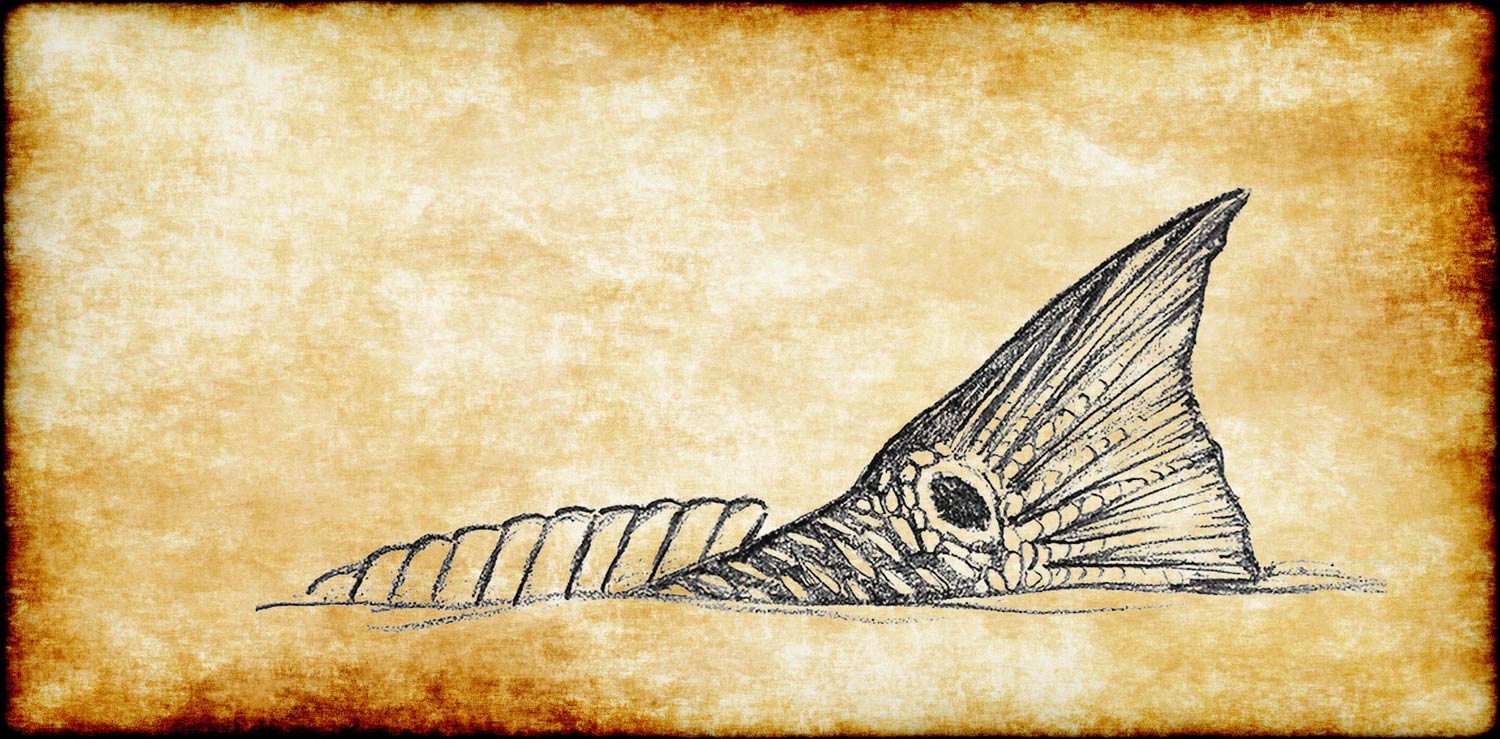
I’m really excited to share a chapter from from Tosh Brown’s new book “Top of the Flood, halfway through a fly fishing life”! I received and advance copy and I can’t say enough about how much I like it. Here’s my quote from the book jacket.
“From the Conch Republic to the northern tundra, via bushplane, kayak, and Mexican ambulance, Tosh Brown takes us on a vicarious thrillride from home waters to storied waters. The subtitle of this book is a modest tag; this could easily be a life and a half.”
Sit back and enjoy, “Confessions of a Fish Counter” by Tosh Brown
THE AFFLICTION STARTED AS A BENIGN QUEST FOR KNOWLEDGE.
NO, REALLY, IT DID.
____
In the fall of 1990, I caught my first redfish near Port Mansfield, Texas. There was a small knot of gulls hovering over a pod of tailers. Shrimp were jumping and tails were flopping and gulls were squawking, and when my line came tight I thought: this is really fun and I need to do this more often.
For the next few years I booked guides up and down the Texas Coast and caught more redfish. Though pricey, that program was working pretty well until my friend Will Myers said, “Hey, I’ve been fishing a few flats near Port Aransas by kayak. They’re covered with redfish, come check it out.” The word “kayak” immediately spawned images of seal skins and harpoons. I had no clue what Will was proposing but I was game to give it a try.
A few weeks later, in June of 1994, I met Will before daylight on the causeway near Port Aransas. Strapped to the roof of his Suburban were two long, skinny 14-foot plastic boats. They were a fairly new breed of roto-molded craft called “sit-on-tops.” No spray skirts required. We slid them off his truck, strung up our rods, and paddled across the Shrimp Boat Channel to a system of shallow flats behind the Lydia Ann Lighthouse. About 20 yards into the first lake, Will slowed to a stop, motioned me forward, and pointed with his paddle.
“There.”
“What?”
“Redfish.”
“Where?”
“There.”
“Oh…dang.”
Thirty feet off his bow was a pile of waggling redfish in a foot of water. Twenty feet beyond that was another group. As I looked out across the flat I could see more pods tailing up. It was almost as if someone had flipped a switch marked “DIG.”
The lake we were fishing had a soft mud bottom laced with oyster reefs. It was too mucky for wading, so the kayaks provided a simple and stealthy means of approach.
For the next six hours Will and I paddled from one tailing pod to the next. When I got back to Austin I stopped at the local paddling shop and bought a sit-on-top kayak and a paddle and a roof rack for my truck. A week later I went back to the same flat and again found it crawling with redfish.
Attractor Midge Larva for Cold Water and Picky Trout
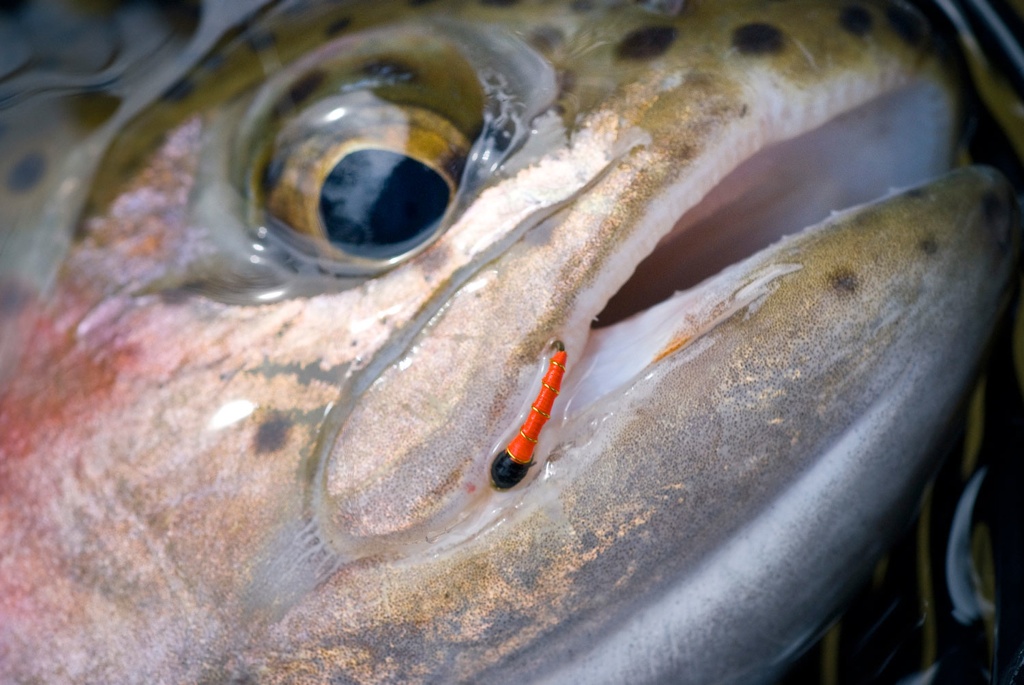
WHEN WATER TEMPERATURES BEGIN TO DROP IN THE FALL AND THE MAJORITY OF OUR BIG HATCHES START TO TAPER OFF, MIDGE PATTERNS BECOME A BIG PLAYER FOR ME.
November through January, when I’m sight fishing and I can’t get trout to eat, I’ll often opt for tying on an attractor midge larva. Quite often, the fish eat them like candy and my clients think I’m a hero. I can hear the words now, “I had no idea you could catch big trout on flies that small”. Make sure you downsize your tippet to 6X or smaller for a more natural drift, and play your big fish easy, otherwise you’ll risk pulling those tiny hooks out of the mouths of big trout. Experiment with bright color combinations with and without beads. One of my favorite attractor midge larva is simply a fluorescent orange thread body, wrapped with fine gold wire, finished off with a black thread head. You can coat them with Sally Hansen’s Clear Nail polish for more shine, but it’s not required to catch fish. These fly patterns are
Read More »How I Almost Owned A Trout Stream
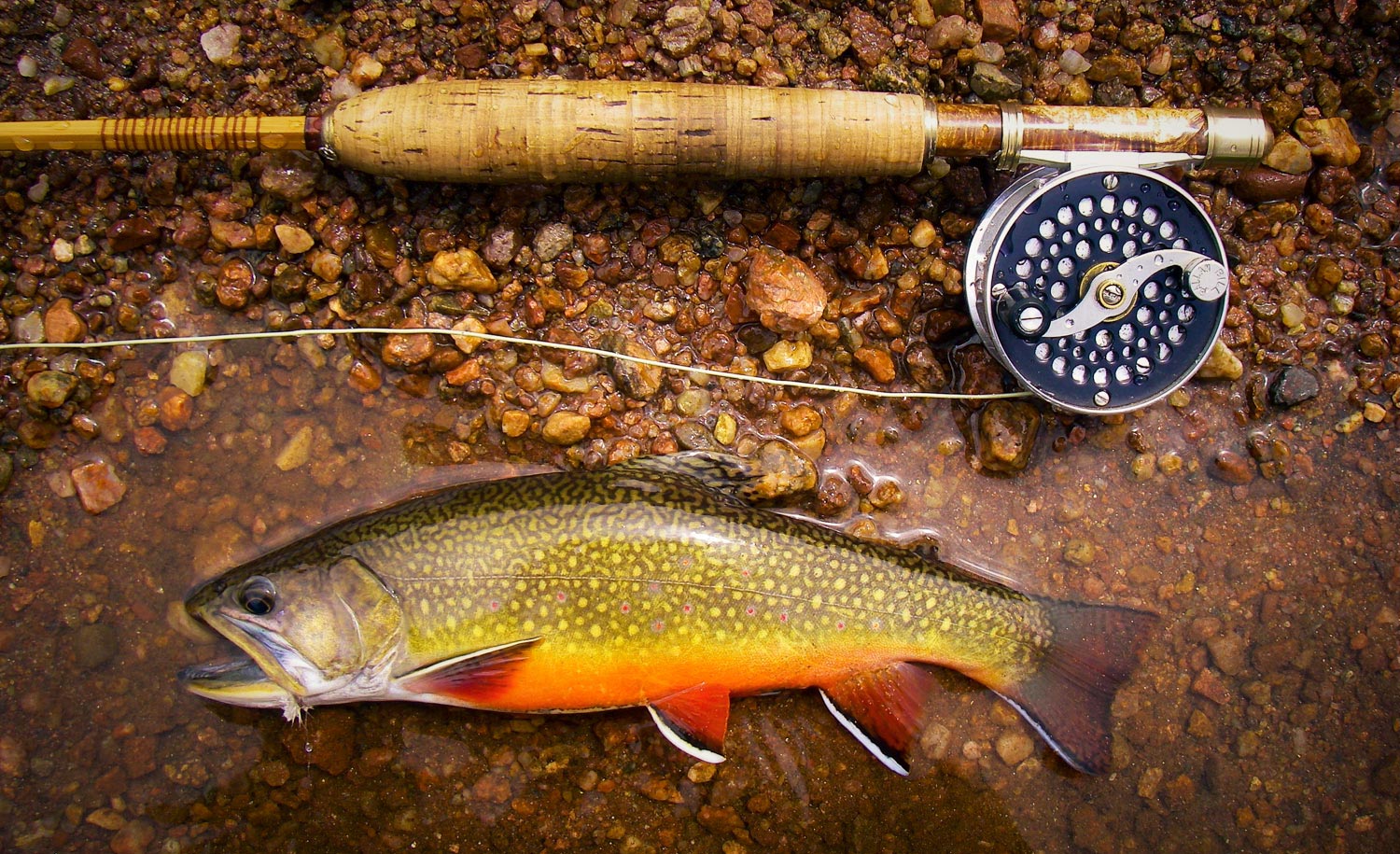
By Jon Tobey
NOW THAT THEY ARE SELLING IT, I CAN FINALLY TELL THE STORY OF WILLIAMSTOWN GULF.
When my dad was in high school, he and his 3 best friends bought a trout stream. I know it sounds like something out of Trout Fishing in America, but they really did. Can you imagine, getting out of school and heading out to your own trout stream, as a teenager, to fish with your best friends? Somehow, that story makes me feel like I really got my priorities completely wrong at a very early age. I didn’t even own a fly rod until I was 40, but I heard about this stream my whole life and finally one day when I was home I asked if I could go fish it. They’ve been stocking if for years even though nobody has fished it for 20 and my dad had to call his one surviving friend to get directions to it. It’s a little creek that becomes a tributary of the White River.
When we finally got there it was in an incredibly dense and verdant valley, but unfortunately the stream had been beaverized, with dams about every 100′ on it and a lush swamp in the resulting river bottom. I had to walk through a very dense swamp to get to it and I was a little nervous because it was filled with moose tracks and from what I’ve heard you would rather run into a bear than a moose. When I finally got to the stream it was about 8′ across, and beneath the dams almost that deep. In the crystal cold water there I could see the fry, every pool holding hundreds and knowing what cannibals trout, especially brook trout, are I imagined each stretch must hold one lunker or so. I mean 20 years….
Read More »Traditional Old-School Nymphs Catch Trout, Don’t Forget It
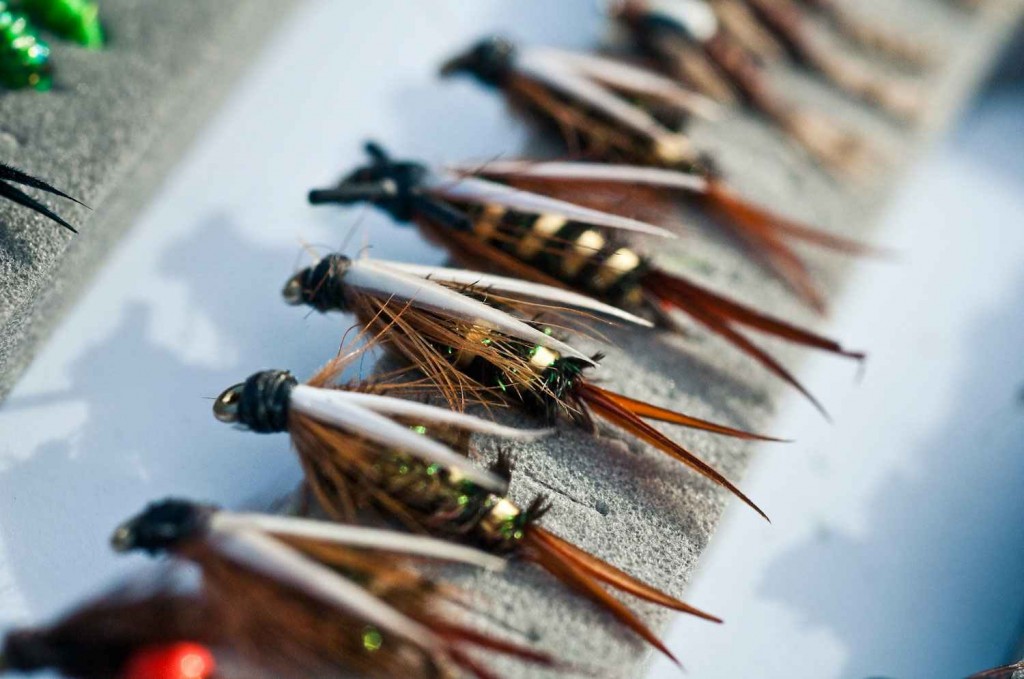
Every year, I spend quite a bit of time scouring the interweb and flipping through numerous fly company catalogs, all in the effort to stay up to date with the latest new fly pattern creations.
Many are just variations of already existing fly patterns, but quite often it’s a new fly tying material that’s created, manipulated, or that’s managed to stay under the radar and discovered, that’s used to develop these new fly patterns. I usually spend my time reviewing the new flies and their recipes, and hear my inner-voice chattering over and over, “why didn’t you come up with that fly pattern, dumby”. But even after purchasing and tying several dozen of the new fly patterns, many of them ultimately fall short on the water of producing trout numbers like my traditional old-school standby nymphs do. Why is that?
I think the the fly tying world is very similar to the rod manufacturing world, where a company builds a great fly rod that 90% of fly anglers love, and then a couple years down the road they discontinue the rod line, to make room for the introduction of the next innovative fly rod. Quite often, in my opinion though, that new rod design’s performance falls short of its predecessor. I know this process is called product life cycle, and it will continue to happen again and again, but it sure seems like we’re in way too much of a hurry to move on, and should instead be more content with sticking with a great product longer. It’s the notion that great isn’t great enough, and that we should retire the greats, in the hopes we can find something, for lack of a better word, that’s perfect. The problem is, there’s no such thing. No one product will work perfect for the infinite number of situations it will encounter on the water. My point being, in the target zone and scope of fly patterns at least, it may benefit many of us if we stop getting lost in creating and searching for the next best fly pattern, and instead spend more time just fishing the fly patterns that have proven to catch fish for us consistently for the past century.
Not long ago, I spent a day floating a very popular tailwater in the Southeast. It has an extraordinary trout population, supporting something like 6,000+ trout per mile. Fly fisherman travel from all over the country to fish it, and many of them go-in thinking presentation aside, that success is going to be determined by fishing the latest hot fly patterns that the fish haven’t seen. They run to
Read More »